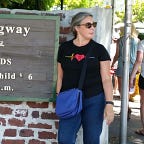#OscarsSoWhite1973: Sacheen Littlefeather Refuses Brando’s Oscar
On the evening of March 29, 1973, a young woman whose dress sparkled with beads ascended the stage at the Dorothy Chandler Pavilion in Los Angeles to decline Marlon Brando’s Oscar for best leading actor in The Godfather. Her name, she said, was Sacheen Littlefeather, and she had a message from Marlon Brando.
“Marlon Brando has asked me to tell you, in a very long speech which I cannot share with you presently, because of time, but I will be glad to share with the press afterwards, that he very regretfully cannot accept this very generous award. And the reasons for this being are the treatment of American Indians today by the film industry — excuse me — and on television in movie re-runs, and also the recent happenings at Wounded Knee. I beg at this time that I have not intruded upon this evening and that we will, in the future… our hearts and our understanding will meet with love and generosity. Thank you on behalf of Marlon Brando.”
Although some accounts of the incident claim that Littlefeather was “booed off the stage,” the video shows that a few jeers were soon drowned out by applause. Viewers’ memories were likely colored by what came next — Clint Eastwood wondering whether he should present the award for Best Picture “on behalf of all the cowboys shot in John Ford westerns over the years”; Raquel Welch saying, “I hope the winner doesn’t have a cause,” before announcing the winner of the Best Actress Oscar; and co-host Michael Caine (who had also been nominated for a best actor award that year) criticizing Brando for “letting some poor little Indian girl take the boos,” instead of “standing up and doing it himself.”
After the ceremony, Littlefeather shared the full text of Brando’s 15-page statement with the press. She had been forced to condense it dramatically after the producer threatened to have her removed from the stage if she spoke for more than 45 seconds. Brando said he did not wish to “offend or diminish this occasion, but I do not feel that I can, as a citizen of the United States, accept this or any award. You are probably saying: ‘What the hell does this have to do with the Academy Awards?’; The answer is that the motion picture community as much as anyone has been responsible for degrading the Indian.”
Hollywood went on the offensive. Littlefeather was trivialized as a “gentle-voiced Apache maiden… in shining braids, explaining as best she could why the most honored actor of the year was letting the chalice pass.” Brando was accused of manipulating the press by, as John Wayne put it, “taking some little unknown girl and dressing her up in an Indian outfit.” And then the media discovered that Littlefeather was an actress whose birth name was Maria Cruz. She was a member of the Screen Actors Guild, and had received a scholarship to the prestigious American Conservatory Theater — but more interesting to the press — she had been Miss American Vampire in 1970. She was labeled a “faux Apache,” and has often been dismissed as an embarrassing footnote to the otherwise glorious tale of the Academy Awards.
The truth about Sacheen Littlefeather is, not surprisingly, more complex than the narrative written for her after the Oscars. Hollywood may have questioned her heritage (and still does), but she is Native American: part Apache, part Yaqui and part Caucasian — or, as says in the video above, “half Indian and half savage — half Indian and half white.” She adopted the name Sacheen Littlefeather in the late 1960s, and still uses it today. She was, as she said on the Oscars stage, the president of the National Native American Affirmative Action Committee, and had been involved in the occupation of Alcatraz Island, where a boat owned by Creedence Clearwater Revival ferried her and other activists back and forth to San Francisco each day. She met Marlon Brando in Washington, DC, where she had spoken to the Federal Communications Commission about race and minorities.
After the Academy Awards, she landed a few more film roles, and Playboy, which had pulled a spread featuring her after the American Indian occupation of Wounded Knee, ran her photos separately in October 1973. Her entertainment career, though, was effectively over. As she told Tracy Humphrey of BaySunday in November 2010, “My career was cut short… There was a period of time that I had to change gears, so to speak, in my life. So I went back to school and became a health educator.”
Littlefeather has never given up her activism. She promotes a number of Native American causes, encouraging Native Americans to work in Hollywood, fighting alcoholism, obesity and diabetes, and caring for Native Americans with AIDS. She is also the coordinator of the Kateri Circle of the Archdiocese of San Francisco, which blends Native American spirituality with Catholic ritual, in honor of Blessed Kateri Tekakwitha, a 17th century Algonquin woman beatified by Pope John Paul II.
She has also maintained her interest in film and television. She co-founded the National American Indian Performing Arts Registry, and has worked on several PBS presentations, including the 1984 Dance in America presentation of “Song for a Dead Warrior,” for which she received an Emmy. More recently, she was involved in the film Reel Injun: On the Trail of the Hollywood Indian, by Cree filmmaker Neil Diamond.
In later years, Brando was uncomfortable talking about Sacheen Littlefeather. Of Brando, Littlefeather once said, “He helped me to become an infamous person. It definitely put me on the map.”
Sacheen Littlefeather’s official website is www.sacheenlittlefeather.net.
Note: This essay originally appeared at newsoftheodd.com (which was recently resurrected by an anonymous benefactor), and found a second home at popbunker.net. It has been lightly rewritten for Medium.
